Mexico Ride Hailing Market Size
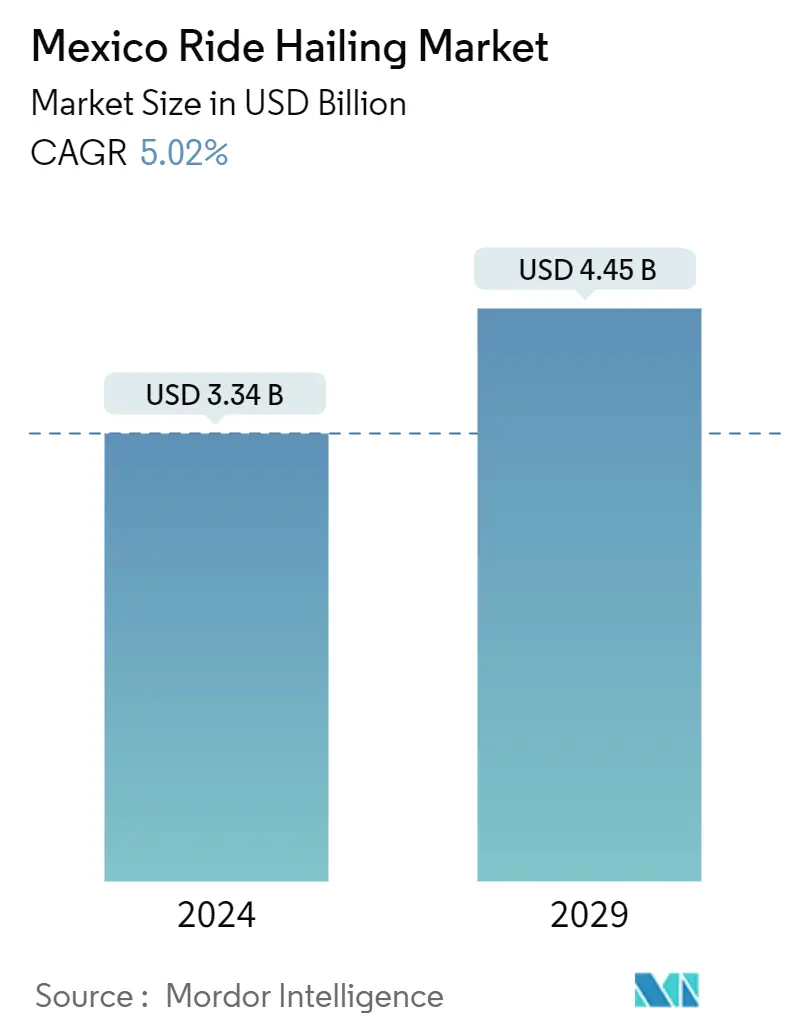
| Study Period | 2019 - 2029 |
| Base Year For Estimation | 2023 |
| Market Size (2024) | USD 3.34 Billion |
| Market Size (2029) | USD 4.45 Billion |
| CAGR (2024 - 2029) | 5.02 % |
| Market Concentration | Medium |
Major Players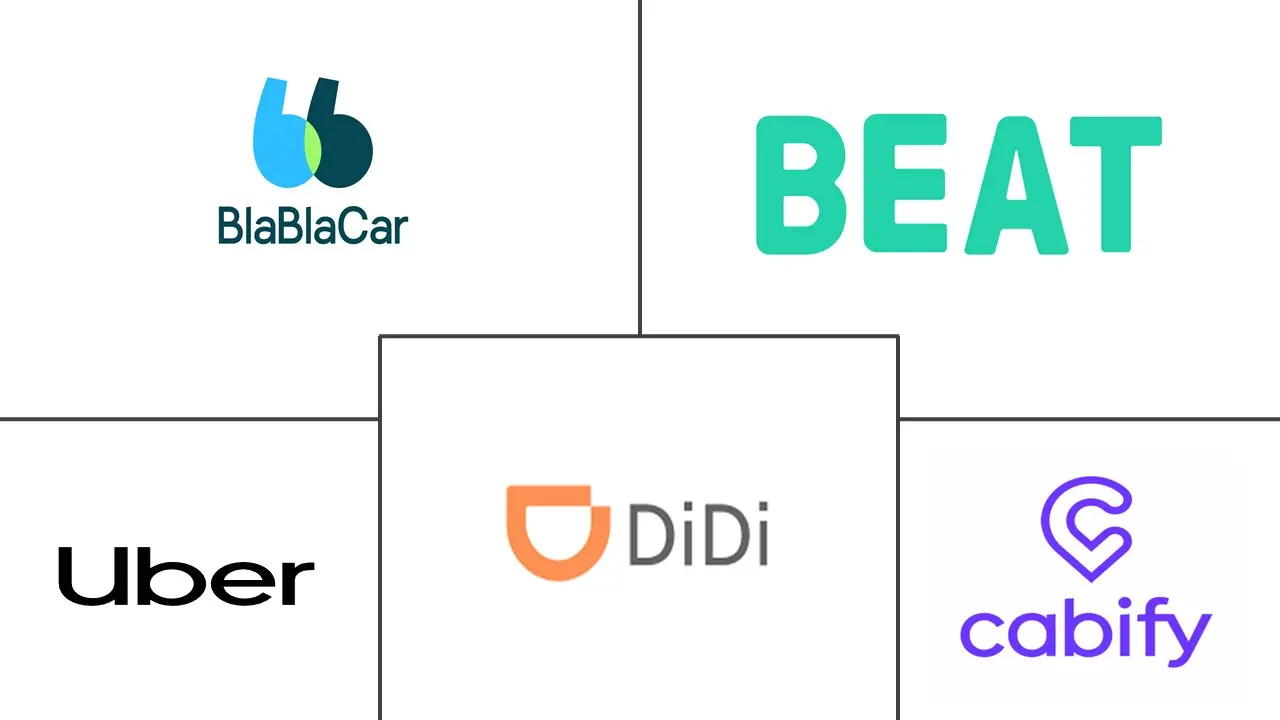
*Disclaimer: Major Players sorted in no particular order |
Need a report that reflects how COVID-19 has impacted this market and its growth?
Mexico Ride Hailing Market Analysis
The Mexico Ride Hailing Market size is estimated at USD 3.34 billion in 2024, and is expected to reach USD 4.45 billion by 2029, growing at a CAGR of 5.02% during the forecast period (2024-2029).
Ride-hailing platforms increase their value when they attract new users and deepen engagement with existing users. Both dynamics grow the network scale and liquidity, further expanding the platform's value to existing drivers and users due to benefits such as route traceability, real-time verification of the driver's location and approach, and electronic payments.
Reduced taxi fares and ease of booking through mobile apps are the major factors driving online taxi booking to capture a significant share in the region. With the advent of e-hailing taxi applications, such as Uber, ride-hailing has been one of the game-changing innovations in the transportation sector.
Uber maintained a significant market share in Mexico, offering various ride options such as UberX, UberPool, and UberBlack across major cities in the country. DiDi, a Chinese ride-sharing company, emerged as a strong competitor, expanding rapidly and providing stiff competition to Uber. Cabify, another prominent player, is focused on providing premium ride options that cater to a slightly different market segment.
Mexico City was a significant hub for ride-sharing services due to its large population and high demand for convenient transportation options. However, ride-sharing services were also prevalent in other major cities like Guadalajara, Monterrey, and Puebla. The Mexican government introduced regulations specific to ride-sharing services to ensure safety, fair competition, and proper taxation. Companies operating in this sector needed to comply with these regulations, which varied across different regions within Mexico.
Mexico Ride Hailing Market Trends
Online Booking Channel is Expected to Drive the Market Growth
- The increasing adoption of smartphones embedded with GPS, linked with the availability of digital road maps through APIs, offered essential supporting facilities such as navigation and tracking for ride-sharing services. The factors in the Mexico ride-sharing market include the development of shared mobility services, such as Uber, Didi Chuxing, and Cabify (Easy Taxi), which are increasingly adopting established transportation business patterns across the region.
- In 2023, over 71% of Mexicans (60 million) use the internet, providing access to ride-sharing apps like Uber and Didi Chuxing. Over 85% of Mexicans own smartphones, the essential tool for booking rides, navigating routes, and managing payments. Also, ride-sharing apps offer a convenient and often affordable alternative to traditional taxis, especially in areas with limited public transportation. The Competitive Intelligence Unit (CIU) reports that internet users in Mexico grew by 2.1% in 2021, reaching 60 million.
- Moreover, Companies operating in this market are offering consumer-centric mobile platforms and various vehicle options to cater to a larger customer base. For instance, Cabify, a private taxi platform similar to Uber, Didi, and Lyft, will soon offer more transportation options in Mexico. Cabify has broken ground in all the capitals of Latin America and, with its new merger announcement, will continue to expand. Cabify, Easy Taxi, and Movo are combining resources to offer transportation on scooters public and private taxis. Such approaches will create more opportunities for ride-hailing market in the region.
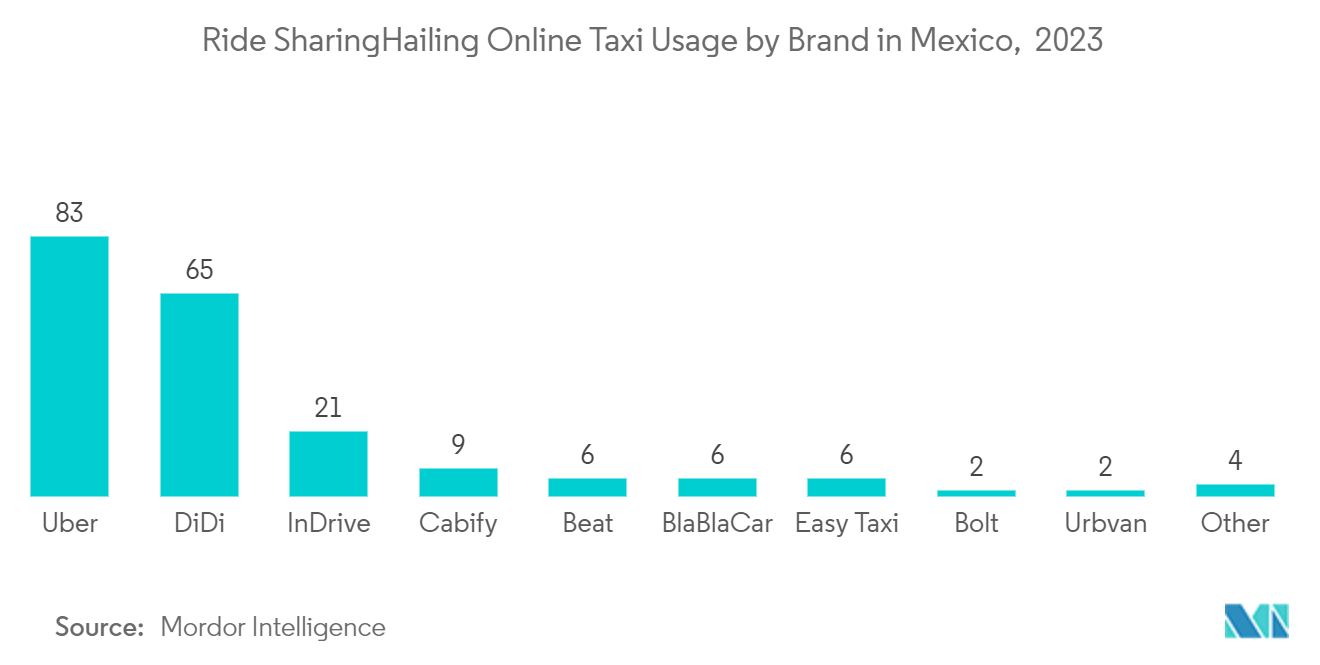
Socio-Economic and Behavioral Patterns Promoting Adoption of Ride-Hailing Industry in Mexico
- Mexico is one of the fastest-growing regions for ride-hailing companies, but there is a gap in knowledge regarding the reasons for this growth and perspectives on its future. There has been extraordinary demand for ride-hailing platforms in Latin America, including Mexico. Their business model has succeeded through a combination of different elements, including geographic factors such as high levels of urbanization, demand for transportation solutions, and poor public transport. Latam is the third-largest car-owning region in the world and has structural labor market conditions.
- Mexico's burgeoning urban middle class, now exceeding 50 million, is fueling the ride-hailing surge. Their growing disposable income and desire for convenient, personalized travel find perfect answers in ride-hailing apps. Car ownership isn't the ultimate status symbol, unlike previous generations – they value experiences and on-demand services that ride-hailing readily provides.
- Millennial and Gen Z Mexicans, comfortable with technology and embracing the sharing economy, readily adopt ride-hailing. They prioritize flexibility and immediacy, viewing car ownership as an unnecessary expense. Smartphone penetration, exceeding 85%, makes accessing and using ride-hailing apps seamless, further propelling adoption.
- Ride-hailing platforms leverage user data to understand demand patterns and tailor services accordingly. Dynamic pricing based on traffic and location ensures affordability, while targeted marketing attracts specific demographics in underserved areas. This data-driven approach caters to evolving user preferences and expands market reach.
- Mexicans are increasingly embracing experiences over material possessions. Ride-hailing aligns with this trend, offering convenience and access without the burden of car ownership. Additionally, concerns about safety and traffic congestion in major cities make professionally driven, reliable alternatives highly appealing. This cultural shift towards shared mobility creates a fertile ground for ride-hailing to flourish.
- Local players like Cabify and Beat cater to specific regions and demographics, offering diverse options. Integrating public transportation systems and business partnerships can further expand reach and create seamless travel experiences.
- The key challenges are Addressing the digital divide, ensuring equitable access, balancing data privacy with user convenience, and promoting sustainable practices like electric vehicles. Overcoming these hurdles and capitalizing on opportunities will determine the future trajectory of Mexico's ride-hailing revolution.
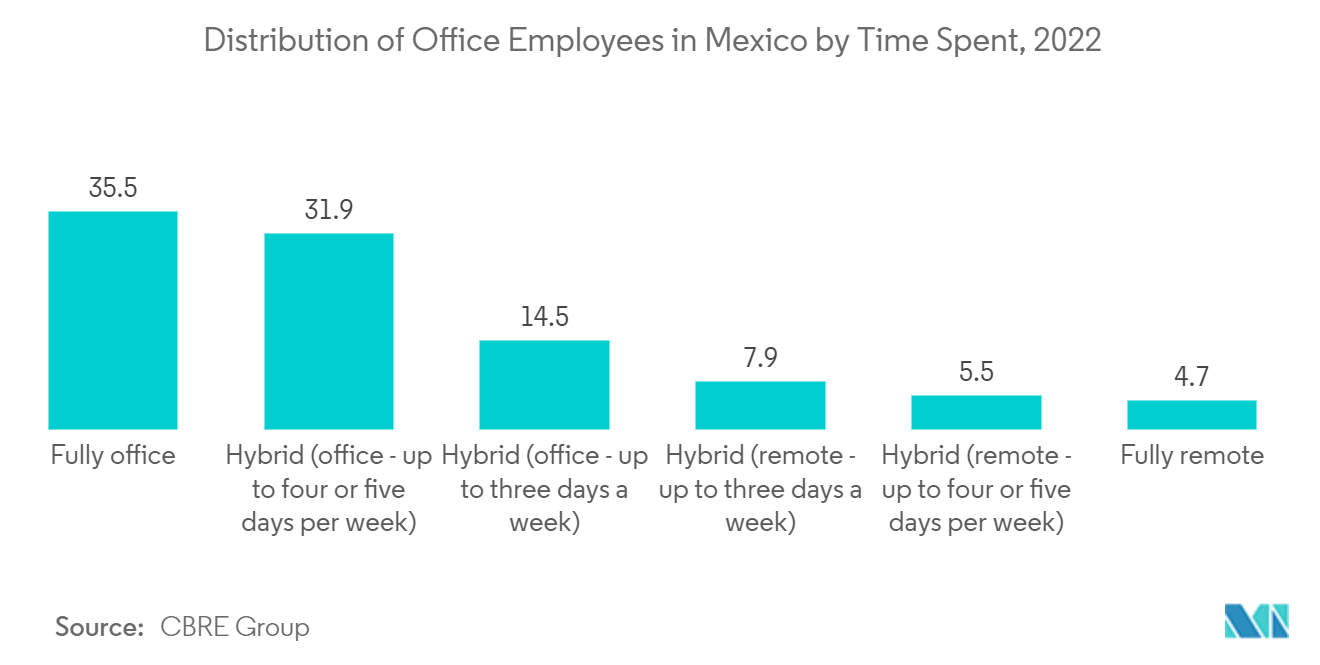
Mexico Ride Hailing Industry Overview
The market in this region is dominated by ride-hailing giants, such as Uber and Lyft, accounting for the majority of the market share. Agreements between corporations and ride-sharing companies to reduce traffic congestion and control pollution from vehicle emissions have been major driving factors of the market in this region.
• In April 2022, Mexican company Vemo ordered 1,000 electric vehicles from BYD to expand its EV taxi fleet. The vehicle in question is the BYD D1, unveiled in 2020 as an electric minivan exclusively designed for ride-hailing. According to BYD, the Mexican fleet of D1s will be the largest EV taxi fleet outside China.
• In April 2022, Lyft, a ride-hailing service provider, expanded its services in Mexico. The company announced the building of a technology hub for Latin America.
• In February 2022, Mexican electric car provider VEMO and U.S. car-hailing platform Uber (UBER.UL) announced an alliance to boost the number of electric vehicles in the platform's Mexico City fleet during 2022.
Mexico Ride Hailing Market Leaders
Uber Technologies Inc.
BEAT
BlaBlaCar
Cabify Spain SLU
Didi Chuxing Technology Co.
*Disclaimer: Major Players sorted in no particular order
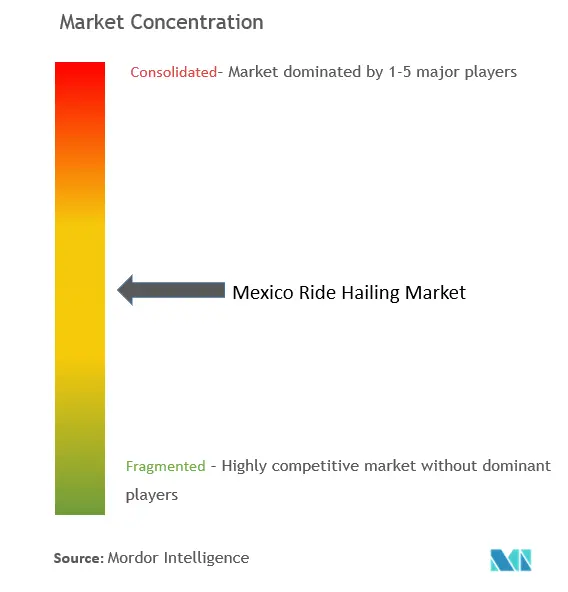
Mexico Ride Hailing Market News
- February 2024: The ride-share platform inDrive collaborated with the financial technology firm R2 to offer loans to its drivers in Mexico.
- July 2023: Hoop Carpool, the shared mobility startup, raised USD 1.3 million in investment funds in a round led by Ship2B Ventures through BSocial Impact Fund, with additional support from Banco Sabadell, FEI, AXIS, and 4Founders Capital.
- June 2022: International Finance Corporation (IFC) invested USD 15 million in BlaBlaCar to support the shared-travel platform's growth in Mexico and Brazil.
- February 2022: Beat, the ride-hailing app, introduced Beat Zero, a new innovative service with a private fleet of fully electric cars operated by hired drivers, to ensure an amazing transportation experience from pick up to drop off.
Mexico Ride Hailing Market Report - Table of Contents
1. INTRODUCTION
1.1 Study Assumptions
1.2 Scope of the Study
2. RESEARCH METHODOLOGY
3. EXECUTIVE SUMMARY
4. MARKET DYNAMICS
4.1 Market Drivers
4.2 Market Restraints
4.3 Industry Attractiveness - Porter's Five Forces Analysis
4.3.1 Threat of New Entrants
4.3.2 Bargaining Power of Buyers/Consumers
4.3.3 Bargaining Power of Suppliers
4.3.4 Threat of Substitute Products
4.3.5 Intensity of Competitive Rivalry
5. MARKET SEGMENTATION (Market size by Value - USD Billion)
5.1 By Service Type
5.1.1 E-Hailing
5.1.2 Car Sharing
5.1.3 Car Rental
5.1.4 Other Service Types
5.2 By Booking Channel
5.2.1 Online
5.2.2 Offline
5.3 By Vehicle Type
5.3.1 Two Wheelers
5.3.2 Passenger Cars
6. COMPETITIVE LANDSCAPE
6.1 Vendor Market Share
6.2 Company Profiles*
6.2.1 Uber Technologies Inc.
6.2.2 Didi Chuxing Technology Co.
6.2.3 Cabify Spain SLU
6.2.4 BEAT
6.2.5 BlaBlaCar
6.2.6 Lyft Inc.
7. MARKET OPPORTUNITIES AND FUTURE TRENDS
Mexico Ride Hailing Industry Segmentation
Ride-hailing is when riders hire a personal driver to take them to a destination. The service is operated online, and the consumers book their rides through an online mobile application.
The Mexican ride-hailing market is segmented by service type (e-hailing, car sharing, car rental, and others), by booking channel (online and offline), and by vehicle type (two-wheelers and passenger cars).
The report offers market size and forecast for Mexico Ride-Hailing in terms of value (USD) for all the above segments.
| By Service Type | |
| E-Hailing | |
| Car Sharing | |
| Car Rental | |
| Other Service Types |
| By Booking Channel | |
| Online | |
| Offline |
| By Vehicle Type | |
| Two Wheelers | |
| Passenger Cars |
Mexico Ride Hailing Market Research FAQs
How big is the Mexico Ride Hailing Market?
The Mexico Ride Hailing Market size is expected to reach USD 3.34 billion in 2024 and grow at a CAGR of 5.02% to reach USD 4.45 billion by 2029.
What is the current Mexico Ride Hailing Market size?
In 2024, the Mexico Ride Hailing Market size is expected to reach USD 3.34 billion.
Who are the key players in Mexico Ride Hailing Market?
Uber Technologies Inc., BEAT , BlaBlaCar, Cabify Spain SLU and Didi Chuxing Technology Co. are the major companies operating in the Mexico Ride Hailing Market.
What years does this Mexico Ride Hailing Market cover, and what was the market size in 2023?
In 2023, the Mexico Ride Hailing Market size was estimated at USD 3.17 billion. The report covers the Mexico Ride Hailing Market historical market size for years: 2019, 2020, 2021, 2022 and 2023. The report also forecasts the Mexico Ride Hailing Market size for years: 2024, 2025, 2026, 2027, 2028 and 2029.
Mexico Ride Hailing Industry Report
Statistics for the 2024 Mexico Ride Hailing market share, size and revenue growth rate, created by Mordor Intelligence™ Industry Reports. Mexico Ride Hailing analysis includes a market forecast outlook to 2029 and historical overview. Get a sample of this industry analysis as a free report PDF download.
